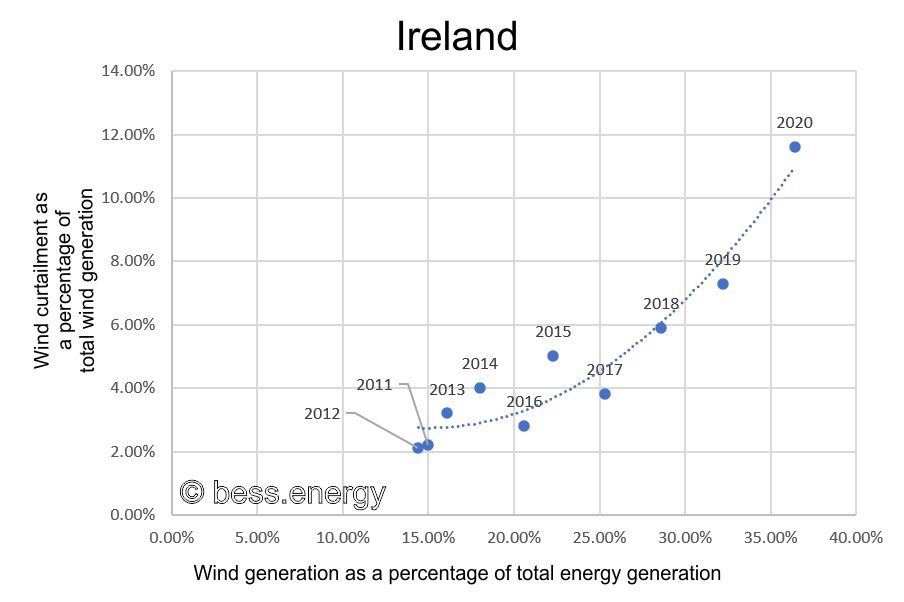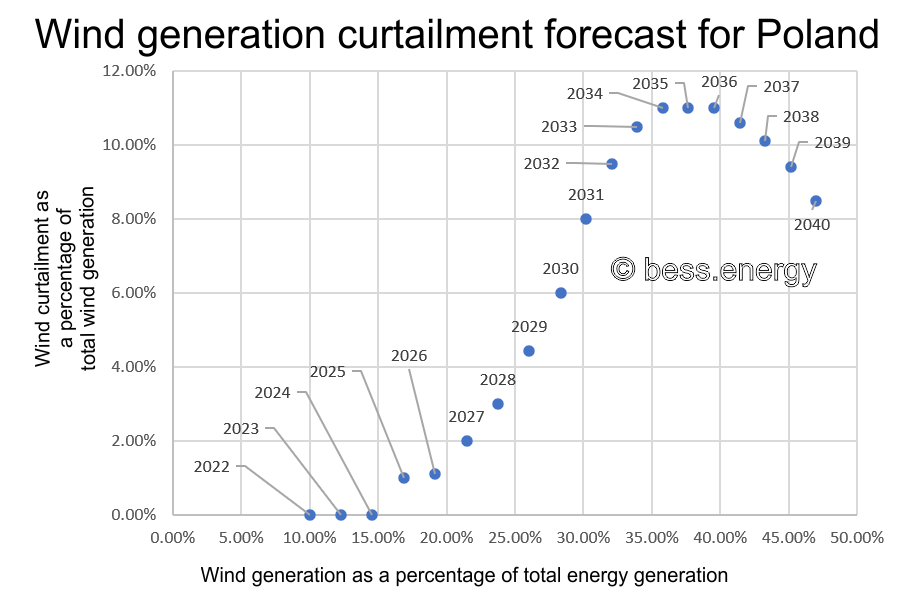The graphs show the scale of wind generation curtailment as a function of the share of wind energy in the energy mix of given countries.



Based on the proprietary model using data from Denmark, Ireland and Great Britain as a training set, the 'bess.energy' model was developed, which forecasts the scale of wind generation curtailment in Poland in the perspective of year 2040. The model takes into account future investments in transmission and distribution infrastructure as well as major large-scale energy storage projects.

The purpose of the model is to calculate the profitability of aggregated investments in large-scale energy storage developed in order to store surplus energy from wind generation for the entire Polish Power System. Using the data for 2022 and PEP 2040 forecasts regarding the volumes of energy from wind sources for 2030 and 2040. Wind Generation for the years 2023 - 2040 was estimated using the interpolation method.
Using the estimates of generation volumes and the curtailment forecast, the volumes of curtailed energy in the horizon of 2040 were estimated.
Given the complexity of the factors that may affect the price of energy, it is not possible to accurately forecast energy prices for the period until year 2040, therefore the simplest method was adopted consisting in extrapolation of the energy price trend based on data for the years 2016-2022.
Combining the above three models, the volume of wind generation curtailment was estimated. The actual curtailment cost includes more components but is not included in this model.
We assume the average CAPEX for the period until 2040 for MWh of Lithium-Ion Battery eEergy Storage System stands at PLN 2.4 million. The CAPEX necessary for the construction of battery energy storages collecting the entire surplus of energy from wind generation is estimated by assuming simplified assumptions about an even distribution of curtailment for each day of the year and a four-hour period of curtailment in a day. The total CAPEX and OPEX for all years until 2040 estimated with the use of the model is by approximately PLN 15 billion lower than the cumulative value of energy stored in the periods of curtailment and sold after the end of over supply period. In the model, we use the projected average annual energy price and do not take into account the possibility of introducing the stored energy to the grid during peak demand hours at prices significantly higher than the average prices.
Deployment of energy storage
to avoid wind generation curtailment has a significant environmental benefit because
during each operation cycle wind energy is not lost and replaces the volume of
energy that would otherwise have to be produced from burning coal.
The presented
calculations do not take into account the environmental benefit of replacing
coal-burning with clean energy. For the overall economic model of energy
storage, it is of course necessary to take into account revenues from the
capacity market or ancillary services, as well as revenues generated by the energy
storage beyond year 2040, which would mostly constitute "pure
profit".
The only task here was
to demonstrate that the inevitable wind generation curtailment, instead of
being a cost, can become revenue in the event of time arbitration with the use
of an energy storage facility on the scale of the entire National Power System.
The required investment of PLN 49 billion would bring PLN 64 billion of revenue
by year 2040 only from the implementation of this one function large-scale
energy storage. Curtailment mitigation would take approx. 36% of operation time
of energy storage, leaving the opportunity to generate revenues from other
markets in the remaining time.
Copyright © 2023 BESS LLC
All rights reserved